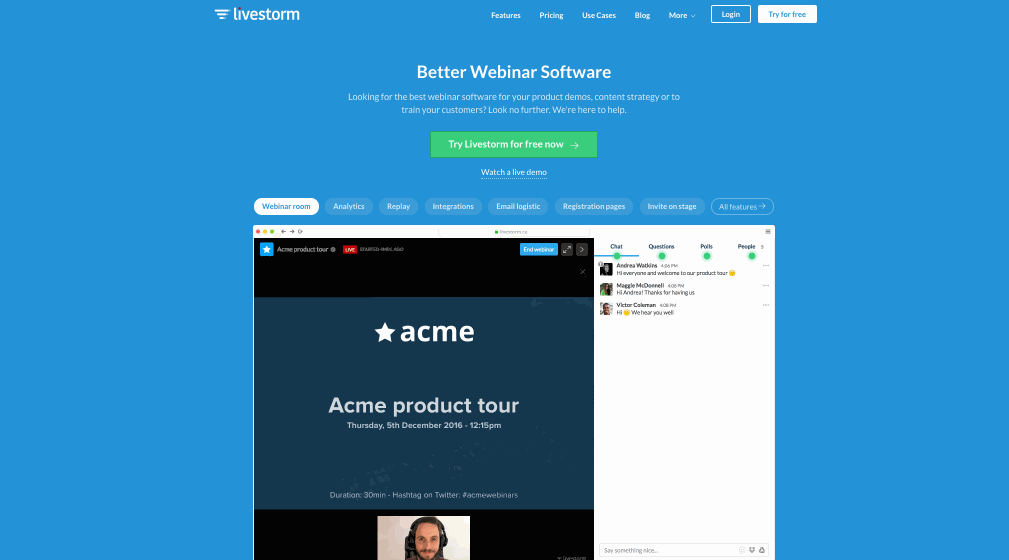How to set-up a lead generation strategy for small businesses: do’s 👍 and don’ts 👎
You’re building a product that can be used on the Internet? Good for you! But then, the thought of finding customers start to creep in. Should you talk about it now? Later? Should build a marketing war machine? Should you play it safe? After a few years of generating demand for companies, here is the gist of what I believe to be the best bet.
1. Keep it simple: kill the marketing war machine
When you want to build demand for your product, and someone says “let’s build a marketing war machine” (or whatever machinery analogy), walk out of the room. Physical machines are complex systems that are prone to bug and break. Marketing war machines are exactly the same. The more complex they get, the more prone to break at the slightest touch they are. Or to put it more plainly, I’d rather go with an old Defender than a brand new full-technology-loaded BMW. Let me show you the beauty of simplicity over bloated-unmanageable-complex systems.
First of all, when you’re a small business, you don’t have the time to do everything. A lot of solo founders run every aspect of their business alone. They code, design, tweet, support. Building a complex demand generation system takes time. A lot of time! But hey, let’s say you take the time and you build you awesome marketing war machine. You’ve put in the time, you’ve built the system, you know how it works, end of the story. The only thing is that you’re the only master here. So unpredictable mistakes are less likely to happen. But when your company’s growing, new people come in. And some of these people will use your marketing machine in ways you wouldn’t imagine (that’s the beauty and the curse of it). What was working smoothly with one (or two people) can become a big pile of 💩 in a matter of weeks.
The more complex a system is, the more asymmetrical the ratio benefits/costs are. Sophisticated systems can be torn down by the smallest error. If you have complex integrations between your marketing tools and your CRM, someone who doesn’t know the ins and outs of your system might make a honest mistake and synchronize thousands of unqualified contacts. Your API calls quota explodes, and your system is gripped until the next day. Sounds dreamy right?
When you build a complex demand gen system, you need to document it. It’s useful but it takes time. Now, let’s face the hard truth, nobody ever reads the documentation. Why? Because marketing tools are so easy to use! It feels like I know what I’m doing. Until it’s too late and I fucked something up. So while I end up reading the documentation, someone else in the team is left to clean the mess.
Time of maintenance grows exponentially with every layer of complexity. When you have complex integrations going back and forth between several tools, it’s easy to loose count of all loose ends. The time you waste in maintenance could be invested in creating more content, in shipping your next update or growing your website’s traffic.
2. Keep it simple redux: start by focusing on two points of entries
This is the number one practical advice I give every small business owner I talk with: focus on two points of entries depending on the buying intention. Just these two. And make these great!
The first people you should focus on are those who desperately want to give you money. They think your product is awesome and they want to try it. Why not taking their money?
You sell courses? Show me the table of content, some nudgets, etc. Paul Jarvis does this superbly. You sell a software? Let me see it and try it. You’re ashamed of showing your product on your website? Now might be a good time to work on that redesign you’ve been avoiding for so long. One way or another, I need to try it! I need that first date to see if your product and I have anything in common.
Ghost.org does a superb job showing off its awesome product (yep, I moved from WP to Ghost a few weeks ago). Another product that is doing this perfectly is Livestorm. Gilles and his team went to great lenghts to show us what the product looks like.

Once you covered these prospects, focus on those who won’t buy just yet. I browse your website, read loads of articles and follow you on Twitter? Cool! I’m window-shopping. I have no intention of buying right now but I have a clear interest in your product. This is what newsletters are for. They keep me informed. They help your company grow your contact base until those who were not ready to buy become ready.
I have this theory (completely unverified, so feel free to prove me wrong 😁) that people know in a split second if they want to buy your product. The hardest part is to help them find the opportunity to do so.
One last thing: stop locking every damn piece of content behind closed doors. No matter how well designed your form is, I won’t give you my email to look at some videos. No, I won’t fill out a 20-field form to download your whitepaper. Make this content freely available. A 80-page whitepaper can be turned into ~30 articles. More words to share with everyone. More useful information that could rank and drive your traffic upward. Open things up!
3. Ruffling some feathers is good for ya
Companies that pledge to play it safe until they have an audience are aplenty. Companies that used this strategy and managed to get a massive following are almost non-existent.
Fear is always a shitty advisor.
When you’re the underdog, you don’t build an audience by being bland and boring. The euphemism “corporate communication” is usually a poor decision motivated by the fear of not pleasing everyone. And let’s be clear, whether you build a product for people or for companies doesn’t matter. Even people working for governmental agencies love to loosen up every now and then. There’s really no need to be so serious all the time.
Leaving a burning trail of good-humoured impertinence is often the best way to stick in your future customers’ mind. Write about your beliefs, set the tone and get shit done. Before being acquired by Trainline, French competitor Captain Train was rocking it. They never shied away from throwing a punch at their competitors’ shitty endeavours.
“You will never reach your destination if you stop and throw stones at every dog that barks” – Churchill
— Andreas Klinger ✌️ (@andreasklinger) October 3, 2017
Let them bark. you got work to do.
People tell you that your marketing is funny and you’re afraid they won’t take you seriously? Don’t run and hide behind the corporate bullshit. It’s probably the tree hiding the forest anyway. They already know they won’t buy from you. Maybe they already spent millions on a competitor or, may be they got used to that other crappy tool and they don’t want to change now. They’d rather give you fake reasons (e.g. “I’m waiting for your product to be more mature”) than real ones (sunk cost fallacy, resistance to change, etc).
Obviously, if you’re Deloitte, well, people expect you to be boring. But even lawyers make cool shit nowadays (in French). So get a spine and get your voice out there.
4. Don’t farm out content
First, don’t do “content”. It’s usually a bad idea to treat words, voices and creativity as a commodity.
Finally, never, ever hire content agencies to write for you. They almost never take the time to get intimate with your business. You always need to spend countless hours correcting their crappy copy. Also, they write soulless boring stuff that will make everyone cringe and flee.
Farming out content usually ends up like this:

5. Be patient and keep shipping day in day out
Building demand takes a lot of time. Get used to the idea.
Looking for shortcuts won’t get you anywhere. Yes, I’m looking at you people spamming people from a list you bought (and killing off your deliverability score in the process 😤 ).
Focus on building a great product, writing cool articles, talking like a human being on Twitter… every single day. These efforts will compound and make the most lasting effect on your sales. And this takes time.
Sure, from time to time, you can look for a bon coup (something that works really really well even though you’re not absolutely sure why). But these one-off projects should be damn cool and useful to the people whose needs you’re looking to address. Otherwise, it’ll just be a flash in the pan.
This part doesn’t sound like advice to you? Well, you’re either doing it naturally and don’t see how people can do it otherwise or you’re in for a very boring demand gen report at year end.
6. Meaning, Strategy, Means
Let’s remind us the three pilars of a job well done:
- the meaning: “Why am I doing this?” 🤔
- the strategy: “Should we build a marketing war machine?” 🙈 (See above for the answer to that question)
- the means: “Am I being given all the information and authority to build something that delivers on its promises?” ¯_(ツ)_/¯
If your team can’t answer these three questions, your demand gen strategy will fail.
Two mistakes I see again and again and again:
- people in charge of the demand gen project are not given the means of doing their job properly (e.g. they can’t say “no” to a shitty idea coming from higher up).
- team members interacting with the demand gen tools lack proper training (or they don’t give a damn about using it properly).
For a demand gen strategy to work (also applies to a lot of other topics), you need to trust someone with the project and give her/him the authority to do so. The owner of the project should have the power to say “yes” or “no” to ideas coming in regardless of the hierarchical position they were emitted from. The owner should have the authority to filter out shitty ideas. There’s no blame to lay on people suggesting shitty ideas. I suggest shitty ideas all the time. But letting shitty ideas move on to production because the owner of the project doesn’t have the company’s full support to say “no”, is the best way to kill your demand gen strategy in the egg.
7. Red tape the tools, not the mind
When I was a stained glass maker (that’ll make for another story), there was this saying:
You recognize the craftsman by its tools.
I had to keep my tools in perfect condition and my workbench clean because a single nail could break a piece of painted glass I’d then have to redo.
When it comes to marketing tools and CRM, your tools should be squeaky clean. I mean Bree van de Kamp clean. For example: define a naming taxonomy for your contact lists, create dos and don’ts in your Trello boards… Give everyone the ability to know what they can do and what they shouldn’t do. Be ruthless when enforcing these rules otherwise it’ll become a huge mess in no time. And believe me, spending a month cleaning everyone’s mess is not something you’ll enjoy.
But let creativity run wild! I see a lot of time invested in “complex” strategies. Honestly, fuck these. Just play around, ship good enough projects to see what stick and what doesn’t. Never stop having fun! This, my friends, is the best advice you can get.
That’s it for today! Lemme know your thought in the comments or on Mastodon!
